Ask any devout Hokie, "Was it a catch?", and he or she will adamantly tell you it was. You don't need to specify that it was the Sugar Bowl, or that the opponent was Michigan, or that it was overtime, or that Logan Thomas was the quarterback. And you certainly don't need to say the receiver was Danny Coale. It was an opportunity to show the nation that Virginia Tech belonged in a BCS bowl; it was a chance to tell the world that the team wouldn't yet again lose to a marquee opponent; it was a thrilling game that had the attention of every football fan in America; it was a catch.
Logan Thomas patiently waits behind strong protection from the line and unleashes a perfectly thrown pass, leading Danny Coale right as he streaks across the end zone with a step on the defender. Coale lays out and grabs the ball one-handed and crashes to the ground. Inexplicably, the replay official reverses the on-the-field call that it was a catch. The game is lost. So is the Virginia Tech offense.
The Basics
Virginia Tech's offense has been nothing short of a roller coaster for many years. Most fans associate the quality of production with its quarterback: Michael Vick, Bryan Randall, and Tyrod Taylor are remembered as part of teams that seemed to give opposing defenses fits, while Grant Noel and Sean Glennon elicit groans. Logan Thomas is an enigma. It's of course not all on the quarterback, but it's the nature of football. When times are good the quarterback gets too much credit, and when times are bad he takes too much blame.
It's futile to try to pick apart each component of the game; line play affects passing affects rushing affects play-calling affects recruiting and so on. Everything fits together like a Jenga game (ask Buzz Williams), and you can only pull so many pieces before everything comes tumbling down. Everything came tumbling down after The Catch but some pieces were missing already.
To get a handle on the state of the Hokie offense, statistics are presented from 2007-2014 (because that is the period they are available for) from several sources for which enough credit cannot be given: Football Outsiders, BCF Toys, and FBS Drive Stats. Common statistics like points per game and yards per game are insufficient, as they don't account for the quality of opponent, starting field position, the quality of one's own defense, etc... So whenever possible statistics are rate- or opponent-adjusted. Please ask any questions about specific statistics in comments.
What Happened to the Points?
The primary role of the offense in football is to score points. There may be secondary goals like controlling the clock or wearing down the defense, but each is irrelevant if the primary goal is not achieved. Since the opposing team affects how many drives the offense is given, scoring can be considered on a per-drive basis:
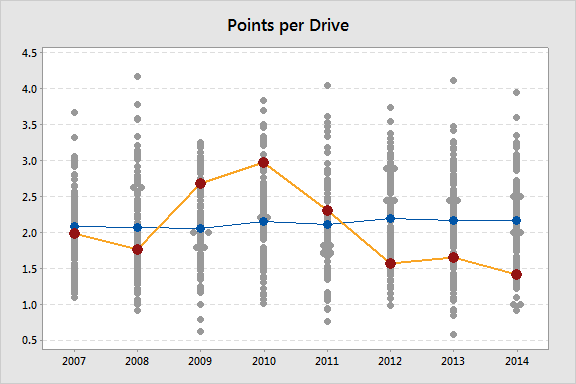
The ability to score peaked Tyrod's senior year (2010), and was already moving downhill quickly at the time of The Catch despite national average remaining fairly stable. (Note: the perceived increase in offense recently is more a function of pace than scoring ability, as many teams simply get more drives per game, but score about the same number of points on each.) The percentage of drives in which the offense scores follows the same pattern:
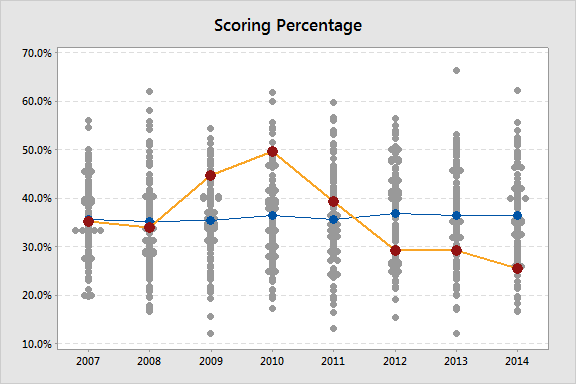
At peak Tyrod, Virginia Tech scored on nearly 50% of offensive drives; fast forward to 2014 and the rate is barely half that. In nearly three out of four drives, the Virginia Tech offense came away with 0 points.
Brian Fremeau, creator of FEI, calculates game splits for the non-garbage time of every college football game. A simple explanation of game split goes like this: Given a certain starting field position, an offense is expected to earn a certain number of points for that drive and they perhaps score actual points or move the ball to field position for another value. From this we can deduce, in points, what each drive was worth (along with special teams, turnovers and extra possessions), sum them for the game (with one team's offensive production being the opposite of the other team's defensive production) and the sum of a team's game splits equals the non-garbage time score difference. To summarize, it's a way to attribute the score difference proportionately to offense, defense, special teams, turnovers and extra possessions.
Here are the offense and defense game splits for all Virginia Tech games, 2007-2014:
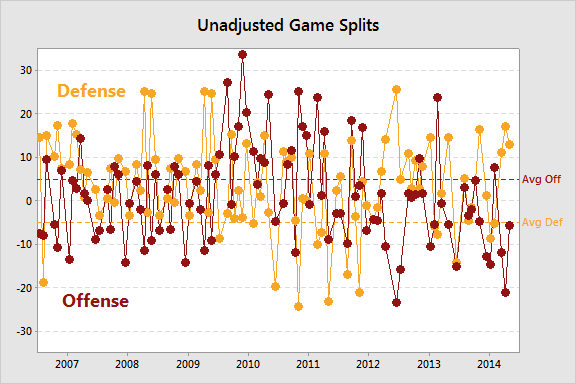
For a period in 2010 and 2011, the offense regularly outperformed the average team; this coincided with a rough patch for Bud Foster's defense in which about a third of games fell significantly below average. Outside of these years there is an interesting pattern: in multiple games, including all but two games this season (ECU and BC) the defense provided more points than the offense. This is in spite of the nearly 10-point advantage the average offense has over the average defense.
The average offensive game split in 2014 was 4.92 points, and conversely the average defensive split was -4.92 points. So a typical offense gains their teams almost 5 points and a typically defense loses that many. The same game splits for Virginia Tech's offense and defense for every game since 2007 were adjusted for these numbers to be relative to average:
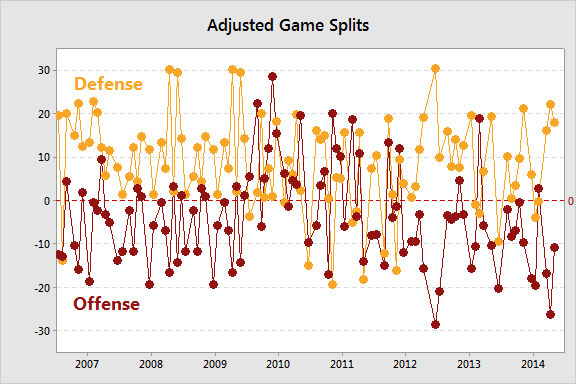
Once you adjust for the baseline, the picture becomes clearer. The Catch was the last offensive play before the Jenga blocks fell. Since that night in New Orleans, the offense's performance has exceeded the defense's performance just twice — the 2013 Miami game and the 2014 Boston College game.
As went Danny Coale's points, so went seemingly all points since.
Move the Ball
Of course an offense isn't good simply because it decides to score points; scoring points is the result of moving the ball and not giving it to the other team. Do both and the team likely scores points. Fail at either and the team likely doesn't score points.
There are two components to moving the ball: the average yards gained per play, and the consistency or variation in yards gained. An offense needs a high enough average, and cannot have too much variation or drives will not be sustained despite a high enough average. Georgia Tech's offense is successful because it simultaneously maintains a high per-play average and high consistency. Virginia Tech's yards per play follows a now familiar trend:
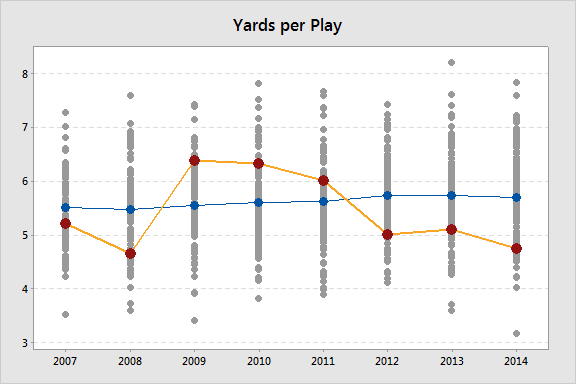
Long-time Hokie faithful most of all miss the ability to successfully run the ball. That leads to the natural question of whether the drop-off in per-play yardage is due to the rushing game, passing game, or both:
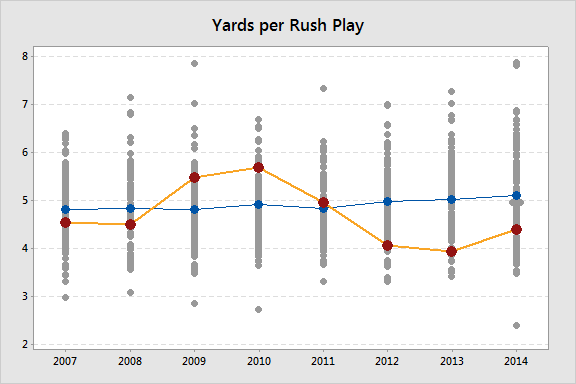
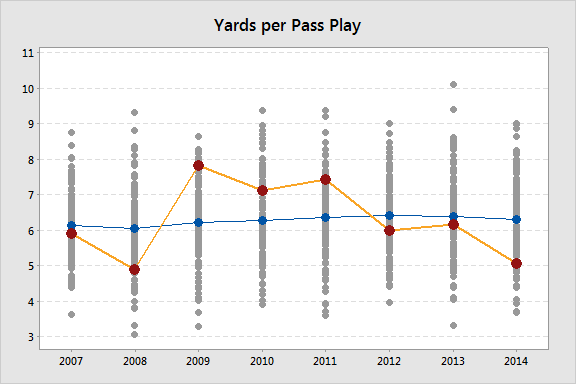
Nationally both statistics have seen a small increase over this time period, while Virginia Tech has seen the same bust-boom-bust pattern for each. The rushing game has, in fact, suffered longer although the passing game in 2014 exhibited one of the worst averages in the nation.
Next is the question of sustaining drives, the other component of successfully moving the ball. For this the basic statistic is yards per drive:

(Note: since teams don't average the same starting field position this statistic can be adjusted to be percentage of available yards; however, in Virginia Tech's case, the graphs are nearly indistinguishable.)
In the year of The Catch, the typical drive saw the Hokies move the ball over 35 yards from the starting point; the past three years have seen this amount decrease by nearly 10 yards.
Don't Give it Away
Even the offenses of 2009-2011 that fans yearn for punted only slightly less than the average team. However, the recent struggles have placed the Virginia Tech offense among the teams that punt most frequently in the entire country. It seems fitting that the 2011 Sugar Bowl featured a 36-yard punt by none other than Danny Coale.
Of course, the advantage of the punt is that it (hopefully) gives the other team the ball much further up the field than the offense stalled. There is a much more devastating way to give the other team the ball, and that is the turnover:
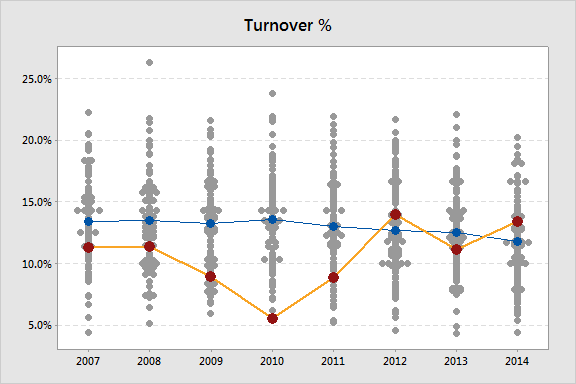
One of the defining characteristics of the Virginia Tech offense for many years was ball protection: in fact, in 2010 the team had a lower percentage of drives end in a turnover than any team in the country at 5.5%. Recent years have seen the team perform around average at best, a rate that is far too high for an offense that doesn't gain enough yardage.
What Is the Identity?
There is little question the identity and personality of the offense has changed in the past few years, but what has changed is not exactly clear. Statistics can validate some of the differences fans have experienced, but as usual in football they are more descriptive than useful in diagnosing specific issues.
When Logan Thomas took the snap that would result in The Catch, he was leading his 10th drive of the game. Just two drives that day had ended in his offense failing to gain a first down: a second half-opening three-and-out, followed by an interception on the first play of the next drive. That 80% rate of gaining a first down was about 10% higher than the 2011 season average, but would be well over 20% above the 2014 season average:
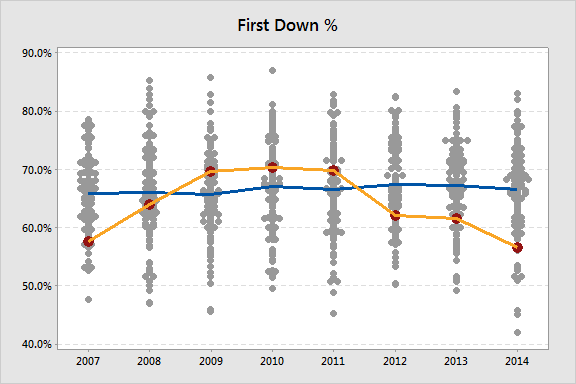
Virginia Tech's offense ranks 117th nationally in first down rate.
Danny Coale isn't just known for The Catch. In fact, if not for the fateful Sugar Bowl play, mentioning the Danny Coale catch would have brought to mind an entirely different game against Nebraska two years earlier. In need of a touchdown with under two minutes to play, Tyrod Taylor connected with Danny on an 80-yard completion that highlighted a 5-play 88-yard drive.
It was the very definition of explosive, and just at the right time. That season the Hokies would have over 17% of drives defined as explosive, averaging more than 10 yards per play:
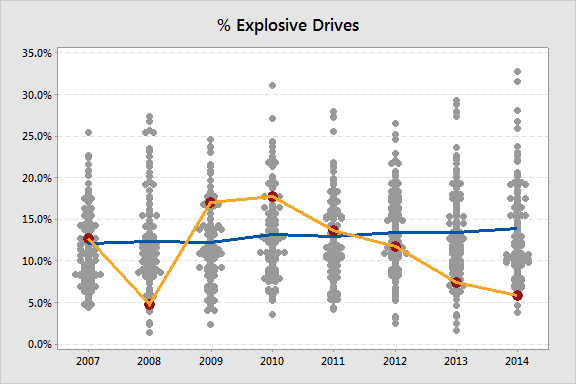
After a slight increase in 2010, the percentage of explosive drives has been on a steady and steep decline ever since, finishing with about 6% in 2014.
Explosiveness is one method of offensive success, but there's another often seen in low-variation teams like Georgia Tech and East Carolina, and that is methodical drives — those of 10 plays or more. Methodical drives is one area where the now-familiar pattern does not hold:
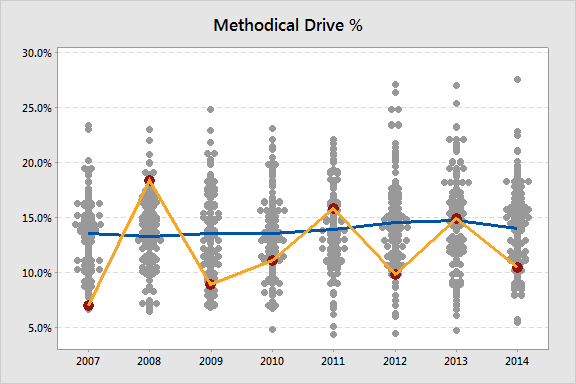
The Hokie offense seems to have settled in a methodical drive percentage a little below the national average of about 14%.
FEI defines one more type of drive: a value drive, one in which a team starts on their own side of the field and moves the ball to at least the opponent's 30-yard line. Unlike methodical drives, this metric returns to the pattern of prior statistics:
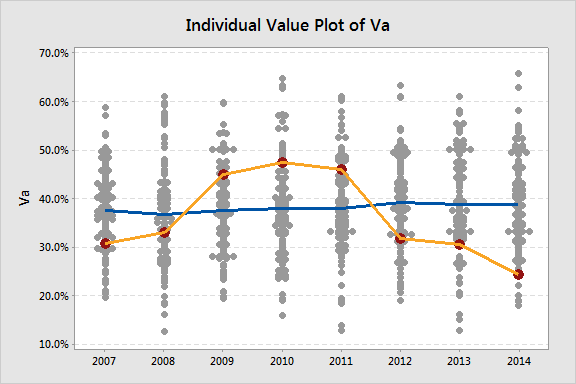
Virginia Tech ranked 122nd in value drives in 2014. There are 128 FBS teams.
Putting It All Together
Everything shown to this point are raw, unadjusted statistics. S&P+ provides some additional context by combining the information to this point with the ability of the opposing defenses to provide an adjusted, best estimate of offensive ability. This is further separated between rushing ability and passing ability:
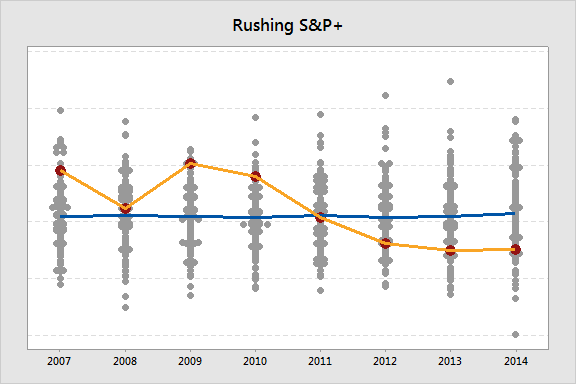

These ratings make clear that offensive woes aren't due solely to the rushing or passing games, and as stated previously those aren't entirely separable anyway. If any glimmer of hope can be taken from these, it's that from 2008 to 2009, under essentially the same quarterback, Virginia Tech went from a below-average passing attack to an elite one. It would be foolish to think that means it will happen again, but worth considering that such a leap in one year is possible.
Finally, a look at the overall S&P+ Offense numbers:
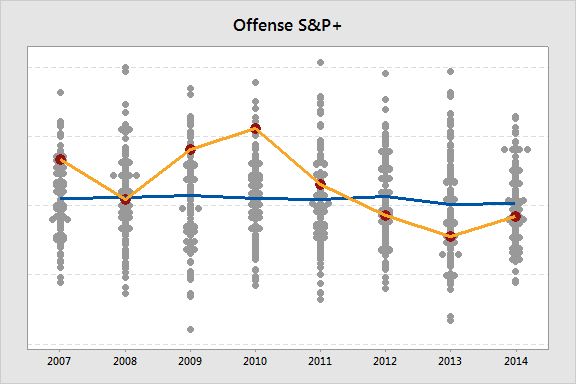
That's the pattern.
The Players
Recruiting rankings are a subjective and inexact science at best, but nevertheless the correlation between a recruit's rankings and his likelihood of performing well and getting drafted to the NFL is strong and indisputable. Danny Coale may have been a two-star recruit before making The Catch, but the quarterback throwing to him was a coveted 4-star recruit (albeit projected to be a college tight end).
As excellent of a job as Virginia Tech as done developing players that were not rated exceptionally high, most of the truly elite players to come out of Virginia Tech were 4- or 5-star recruits. It has been a very long time since Virginia Tech has attracted a 5-star recruit on offense, and none appear to be coming in the near future.
However, it is worth looking at the average rating of offensive recruits (for this analysis the offense was credited for those recruited as athletes even though some ended up on defense) starting in 2006 to examine any patterns that may appear:
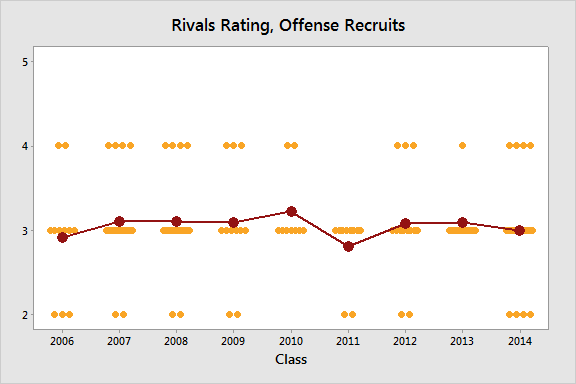
Outside of brief swings in 2010, when no 2-star recruits signed, and 2011, when no 4-star recruits signed, Tech consistently signed just slightly higher than 3-star offensive talent. When one considers the development of players at Virginia Tech, it is often on the defensive side of the ball; Tyrod Taylor, Ryan Williams, David Wilson, both Vicks, Kevin Jones, etc... were all highly-rated entering Virginia Tech.
Putting It All Together
If the play called doesn't put Danny Coale in a position to make The Catch, the ball never gets thrown his way. If the offensive line doesn't provide pass protection, Logan Thomas gets sacked, throws it away or tries a desperate scramble for first down. If Coale doesn't run his route well, he never gets that step on the defender. If Logan Thomas doesn't put the throw in just the right place, it falls incomplete. If the review official doesn't erroneously reverse the call on the field, Virginia Tech wins the Sugar Bowl. The Catch happened because each piece was successful, and it didn't happen because of events outside of its control.
There is no question that the Hokie offense suffered a decline after 2010 or 2011, and currently sits well below average. Nothing in statistics can clearly point to just one aspect of the offense that is to blame. Just as each piece had to be successful to make The Catch happen, each piece must be successful to make the offense click. It's possible that the pieces are there and events outside of the team's control — especially injuries — have sabotaged progress. Or it could be that at least one of those pieces is failing and holding back the others. It is easy to find fault in all aspects of the offense this year, but also easy to find reason for hope.
The offensive line often looked like a wet paper sack, but in the middle of the onslaught was Wyatt Teller pancaking some helpless defender.
Tech's running game often failed to make it back to the line of scrimmage, but we saw real talent from two true freshman tailbacks early in the season, and J.C. Coleman has recently lived up to his 4-star hype.
Michael Brewer threw some really brutal interceptions, but he was absolutely abused by defenders all season and kept getting up.
Scot Loeffler's game plans often seemed too complicated and play calling wrong for the situation, but then he called a great game against Virginia to make it 1.1 x 10^1 in a row.
Wake Forest happened. But so did Ohio State.

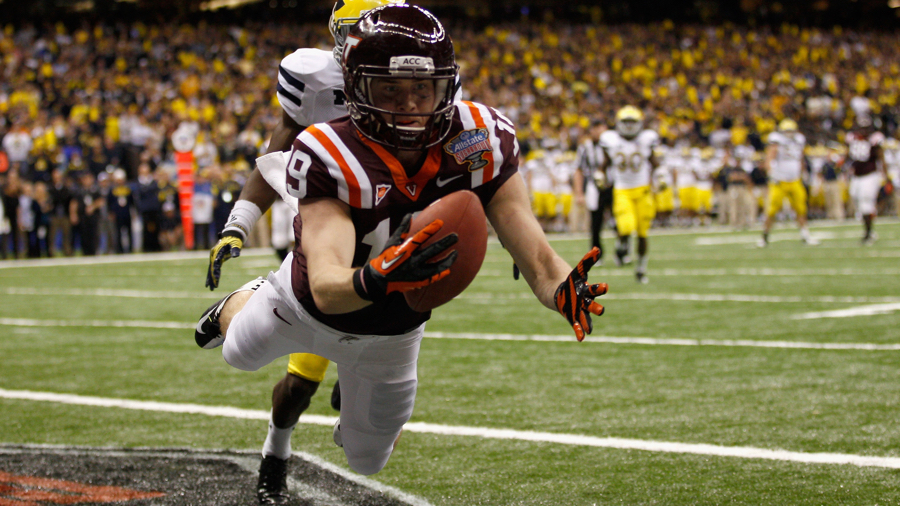
Comments
Please join The Key Players Club to read or post comments.
Please join The Key Players Club to read or post comments.
Please join The Key Players Club to read or post comments.
Please join The Key Players Club to read or post comments.
Please join The Key Players Club to read or post comments.
Please join The Key Players Club to read or post comments.
Please join The Key Players Club to read or post comments.
Please join The Key Players Club to read or post comments.
Please join The Key Players Club to read or post comments.
Please join The Key Players Club to read or post comments.
Please join The Key Players Club to read or post comments.
Please join The Key Players Club to read or post comments.
Please join The Key Players Club to read or post comments.
Please join The Key Players Club to read or post comments.
Please join The Key Players Club to read or post comments.
Please join The Key Players Club to read or post comments.
Please join The Key Players Club to read or post comments.
Please join The Key Players Club to read or post comments.
Please join The Key Players Club to read or post comments.
Please join The Key Players Club to read or post comments.
Please join The Key Players Club to read or post comments.
Please join The Key Players Club to read or post comments.
Please join The Key Players Club to read or post comments.
Please join The Key Players Club to read or post comments.
Please join The Key Players Club to read or post comments.
Please join The Key Players Club to read or post comments.
Please join The Key Players Club to read or post comments.
Please join The Key Players Club to read or post comments.
Please join The Key Players Club to read or post comments.
Please join The Key Players Club to read or post comments.
Please join The Key Players Club to read or post comments.
Please join The Key Players Club to read or post comments.
Please join The Key Players Club to read or post comments.
Please join The Key Players Club to read or post comments.
Please join The Key Players Club to read or post comments.
Please join The Key Players Club to read or post comments.
Please join The Key Players Club to read or post comments.
Please join The Key Players Club to read or post comments.
Please join The Key Players Club to read or post comments.
Please join The Key Players Club to read or post comments.
Please join The Key Players Club to read or post comments.
Please join The Key Players Club to read or post comments.
Please join The Key Players Club to read or post comments.
Please join The Key Players Club to read or post comments.
Please join The Key Players Club to read or post comments.
Please join The Key Players Club to read or post comments.
Please join The Key Players Club to read or post comments.
Please join The Key Players Club to read or post comments.
Please join The Key Players Club to read or post comments.
Please join The Key Players Club to read or post comments.
Please join The Key Players Club to read or post comments.
Please join The Key Players Club to read or post comments.
Please join The Key Players Club to read or post comments.
Please join The Key Players Club to read or post comments.
Please join The Key Players Club to read or post comments.
Please join The Key Players Club to read or post comments.
Please join The Key Players Club to read or post comments.
Please join The Key Players Club to read or post comments.
Please join The Key Players Club to read or post comments.
Please join The Key Players Club to read or post comments.
Please join The Key Players Club to read or post comments.
Please join The Key Players Club to read or post comments.
Please join The Key Players Club to read or post comments.
Please join The Key Players Club to read or post comments.
Please join The Key Players Club to read or post comments.
Please join The Key Players Club to read or post comments.
Please join The Key Players Club to read or post comments.
Please join The Key Players Club to read or post comments.
Please join The Key Players Club to read or post comments.
Please join The Key Players Club to read or post comments.
Please join The Key Players Club to read or post comments.
Please join The Key Players Club to read or post comments.
Please join The Key Players Club to read or post comments.
Please join The Key Players Club to read or post comments.
Please join The Key Players Club to read or post comments.
Please join The Key Players Club to read or post comments.
Please join The Key Players Club to read or post comments.
Please join The Key Players Club to read or post comments.
Please join The Key Players Club to read or post comments.
Please join The Key Players Club to read or post comments.
Please join The Key Players Club to read or post comments.
Please join The Key Players Club to read or post comments.
Please join The Key Players Club to read or post comments.
Please join The Key Players Club to read or post comments.
Please join The Key Players Club to read or post comments.
Please join The Key Players Club to read or post comments.
Please join The Key Players Club to read or post comments.
Please join The Key Players Club to read or post comments.
Please join The Key Players Club to read or post comments.
Please join The Key Players Club to read or post comments.
Please join The Key Players Club to read or post comments.
Please join The Key Players Club to read or post comments.
Please join The Key Players Club to read or post comments.
Please join The Key Players Club to read or post comments.
Please join The Key Players Club to read or post comments.